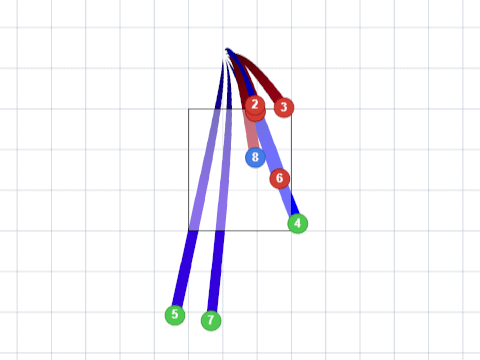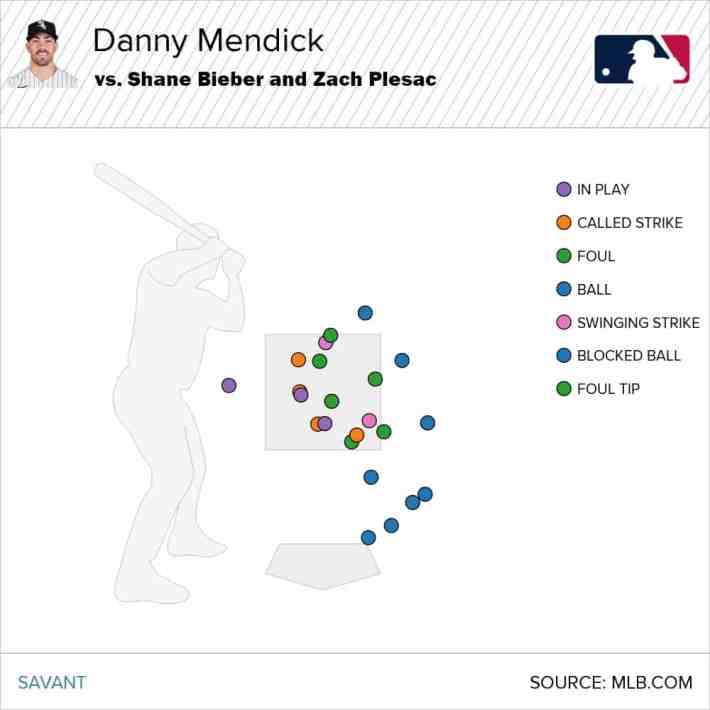Monday's loss to the Tigers had precisely one (1) White Sox highlight: Danny Mendick's triple to the left-center gap that resulted in the lone Chicago run.
I suppose it qualifies as a highlight because the White Sox hadn't yet produced a triple on the season, but from our White Sox-specific lens, it stands out more for how Mendick got there.
Mendick fell behind 0-2 against Jose Cisnero, swinging through one 96-mph fastball at the top of the zone, then fouling another one back. Cisnero tried one more up there, and Mendick deflected it foul to the right.
After three swings on three fastballs, a broadcaster might say that Mendick was in "swing mode." Cisnero tried to change his eye level. A slider bounced two feet in front of the left-handed batter's box. A sinker required a five-hole save from the catcher. Mendick flinched neither time.
Cisnero returned to the zone with a rolling slider, but he located it well enough on the outside corner. Mendick was out in front protecting against 96, but he was able to reach out and tap 85 foul.
Cisnero responded with a more competitive chase pitch, but Mendick checked his swing, feeling comfortable enough in his restraint to call for an appeal himself. With a full count, the bases empty and a two-run lead, Cisnero had no more reason to nibble, so he went right at Mendick with a center-cut four-seamer at 97. Mendick capitalized.
Here's what that battle looks like in Gameday form:

* * * * * * * * *
Fend off the tough pitches, spit on the chase attempts, and drive the mistakes. It seems simple, but hitting is a naturally difficult task even by sport standards, and White Sox hitters in particular have a tendency of treating the strike zone as some sort of Gordian knot.
The reason I'm writing about Mendick is because while the triple was rare, it was the product of a process that's been routine for him. He went 3-for-4 against the Tigers while seeing 20 pitches, and most of them came after falling behind 0-2. You saw the triple, but the other at-bats are just as disciplined.
First at-bat: Michael Fulmer dropped in a first-pitch curve, then a low-and-away fastball that Mendick fouled off. He let Fulmer waste a slider well off the plate, and when Fulmer returned to the zone with a high sinker, Mendick shot it to right field for a single.
Second at-bat: Mendick flirted with passivity when he took a Daniel Norris fastball for strike one, then a lower, plate-splitting fastball for strike two. But he once again looked comfortable against the wall, fouling off a quality changeup just below the zone, then rifling an outer-half fastball off the body of C.J. Cron. A spectacular recovery from Norris was the only thing between Mendick and a perfect day at the plate.
Fourth at-bat: Mendick took Bryan Garcia's elevated sinker for strike one, then fell behind 0-2 because Dan Iassogna gave Garcia a sinker off the plate inside. Just like the Fulmer and Cisnero sequences, Mendick shrugged at an 0-2 slider that wasn't close. Garcia then returned to a sinker inside, but he didn't bury this one, and Mendick inside-outed it to right field.

And he's not just doing it against the Tigers. In the two series against Cleveland, Mendick's been the rare right-handed hitter to force Shane Bieber and Zach Plesac to return to the strike zone, with only one ill-advised swing out of 23 pitches.

Mendick didn't quite get the results against the Indians that he enjoyed during the opener at Comerica Park, but if every White Sox hitter chased one out of 23 pitches, Dallas Keuchel wouldn't be venting right now.
* * * * * * * * *
As it stands, Mendick cuts a distinct profile on White Sox plate discipline leaderboards. He might not be the only one who can tell a ball from a strike, as two other White Sox have a chase rate below 30 percent. However, he's the only one who isn't letting the sketchy early-season umpiring dictate the success of his at-bats.
| Player | PA | O-Swing% | Z-Swing% | O-Contact% | Contact% |
|---|---|---|---|---|---|
| Danny Mendick | 36 | 23.6 | 60.0 | 90.5 | 87.3 |
| Yasmani Grandal | 61 | 25.0 | 46.8 | 45.5 | 64.2 |
| Zack Collins | 15 | 8.8 | 70.6 | 33.3 | 63.0 |
| White Sox | 653 | 34.2 | 66.0 | 60.3 | 73.1 |
Mendick has the second-highest contact rate on pitches outside the zone for players with 20 plate appearances, one-tenth of a percent behind Minnesota plate coverage king Luis Arraez, and ahead of Nick Madrigal's vaunted hand-eye coordination. Not all contact is good -- Nicky Delmonico had the second-highest contact rate in the league behind David Fletcher of the Angels, and little of it impressed -- but Mendick's had a way of bringing pitchers back into the meatier part of the zone.
(It's been even more pronounced over the last five games. Mendick is chasing 21.5 percent of pitches outside the zone, while four different White Sox are over 40 percent.)
As a result, he's hitting .303/.361/.394 through 36 plate appearances, and he's 9-for-20 over this five-game skid, which stands out when the rest of the team is batting .177. The White Sox lost Madrigal and gained Madrigal Plus in his stead.
The results could be short-lived because the quality of contact doesn't stand out. He's hit just three balls over 100 mph, and two of them stayed on the ground, which is representative of the lift he's getting. But just like Leury García, it's hard to complain about emergency production in whatever form it takes, and Mendick's providing a logic to his line. The hope is that he can hold it together on a week-to-week basis, with García tagging in to prevent either from getting overexposed. Greater hopes ride on the team's physically stronger hitters getting it together. If they had even half of Mendick's discipline, they'd be more than halfway decent.
(Photo by Zach Bolinger/Icon Sportswire)





